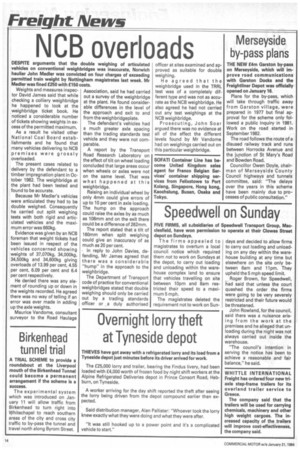NCB overloads
Page 18

If you've noticed an error in this article please click here to report it so we can fix it.
DESPITE arguments that the double weighing of articulated vehicles on conventional weighbridges was inaccurate, Norwich haulier John Medlar was convicted on four charges of exceeding permitted train weight by Nottingham magistrates last week. Mr Medler was fined E250 with £150 costs.
Weights and measures inspector David James said that while checking a colliery weighbridge he happened to look at the weighbridge ticket book. He noticed a considerable number of tickets showing weights in excess of the permitted maximum.
As a result he visited other National Coal Board establishments and he found that many vehicles delivering to NCB premises were grossly overloaded.
The present cases related to delivery by the defendant to a timber impregnation plant in October 1982. The weighbridge at the plant had been tested and found to be accurate.
Because Mr Medler's vehicles were articulated they had to be double weighed. Consequently he carried out split weighing tests with both rigid and articulated vehicles and the maximum error was 660kg.
Evidence was given by an NCB foreman that weight tickets had been issued in respect of the vehicles concerned showing weights of 37,070kg, 34,000kg, 34,500kg and 34,600kg giving overloads of 13.99 per cent, 4.55 per cent, 6.09 per cent and 6.4 per cent respectively.
He denied there was any element of rounding up or down in the weights recorded. He agreed there was no way of telling if an error was ever made in adding up the axle weights.
Maurice Vandome, consultant surveyor to the Road Haulage Association, said he had carried out a survey of the weighbridge at the plant. He found considerable differences in the level of the approach and exit to and from the weighbridgeplate.
The defendant's vehicles had a much greater axle spacing than the trading standards test vehicle and they were not comparable.
A report by the Transport Road Research Laboratory on the effect of tilt on wheel loading concluded that large areas occur when wheels or axles were not on the same level. That was what happened at this weighbridge.
Raising an individual wheel by only 4mm could give errors of up to 10 per cent in axle loading. The hump on the approach could raise the axles by as much as 108mm and on the exit there could be a difference of 262mm.
The report stated that a tilt of 160mm when split weighing could give an inaccuracy of as much as 20 per cent.
• In reply to John Davies, defending, Mr James agreed that there was a considerable "hump" in the approach to the weighbridge.
The Department of Transport code of practice for conventional weighbridges stated that double weighing should only be carried out by a trading standards officer or , a duly authorised officer at sites examined and approved as suitable for double weighing.
He agreed that the weighbridge used in the TRRL test was of a completely different type and was not as accurate as the NCB weighbridge. He also agreed he had not carried out any test weighings at the NCB weighbridge.
Prosecuting, John Soar argued there was no evidence at all of the effect the different levels found by Mr Vandome had on weighings carried out on this particular weighbridge.
















































































